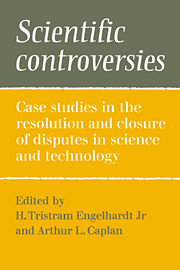 Scientific Controversies
Scientific Controversies Book contents
- Frontmatter
- Contents
- Preface
- List of contributors
- Introduction: Patterns of controversy and closure: the interplay of knowledge, values, and political forces
- PART I THEORETICAL PERSPECTIVES
- 1 Ethical theory and the problem of closure
- 2 Scientific controversy and its termination
- 3 The political anatomy of controversy in the sciences
- 4 Controversies involving science and technology: a theoretical perspective
- 5 Politics, public policy-making, and the process of reaching closure
- 6 The role of experts in scientific controversy
- 7 The continental drift debate
- 8 How history and politics affect closure in biomedical discussions: the example of the Soviet Union
- 9 Scientific disputes over policy
- 10 Controversies and the authority of science
- 11 Post-Skinner and post-Freud: philosophical causes of scientific disagreements
- PART II CONTEMPORARY CASE STUDIES
- PART III CONTROVERSY, CLOSURE, AND THE PUBLIC
- Author index
- Subject index
5 - Politics, public policy-making, and the process of reaching closure
Published online by Cambridge University Press: 03 February 2010
- Frontmatter
- Contents
- Preface
- List of contributors
- Introduction: Patterns of controversy and closure: the interplay of knowledge, values, and political forces
- PART I THEORETICAL PERSPECTIVES
- 1 Ethical theory and the problem of closure
- 2 Scientific controversy and its termination
- 3 The political anatomy of controversy in the sciences
- 4 Controversies involving science and technology: a theoretical perspective
- 5 Politics, public policy-making, and the process of reaching closure
- 6 The role of experts in scientific controversy
- 7 The continental drift debate
- 8 How history and politics affect closure in biomedical discussions: the example of the Soviet Union
- 9 Scientific disputes over policy
- 10 Controversies and the authority of science
- 11 Post-Skinner and post-Freud: philosophical causes of scientific disagreements
- PART II CONTEMPORARY CASE STUDIES
- PART III CONTROVERSY, CLOSURE, AND THE PUBLIC
- Author index
- Subject index
Summary
In writing constitutions and framing governments, the authors focus on the structure of governments (i.e., which institutions and offices of government will be formed), the powers assigned to those who will govern, the limits to be placed on rulers, and rules or criteria for reaching official decisions (e.g., that the “majority rules,” or that a presidential veto of a congressional action will stand unless two-thirds of the Congress votes to override the veto).
In the United States, particular attention has been paid to the rules for reaching official decisions. These rules have been a topic of debate or discussion since the original debates over the U.S. Constitution. In characterizing the traditions of American liberty, John P. Roche notes:
First … there is … the proposition that when all the fighting is over and all the pluralities have had their licks, a public policy which incorporates “justice and the general good” will emerge. Taken for granted here is a willingness on the part of all participants to play by the rules. A faction may disagree about substantive matters – about the content of particular items of policy – but it will not overturn the cardtable and shoot the other players. In short, there will be procedural consensus. (Roche, 1967)
These rules of decision making providing for “procedural consensus” are not designed to dictate specific substantive outcomes; instead, they are meant to formulate a process that will ensure fair, equitable, and “democratic” outcomes.
The process specifies the mechanisms that will be employed by political and organizational actors in their official interactions.
- Type
- Chapter
- Information
- Scientific ControversiesCase Studies in the Resolution and Closure of Disputes in Science and Technology, pp. 151 - 168Publisher: Cambridge University PressPrint publication year: 1987


